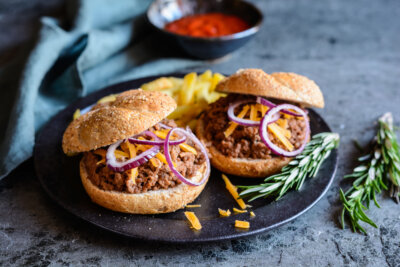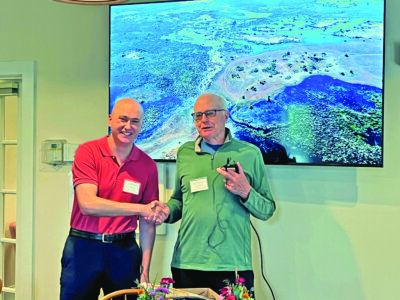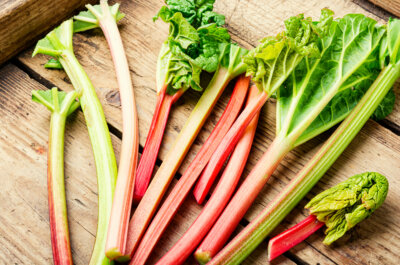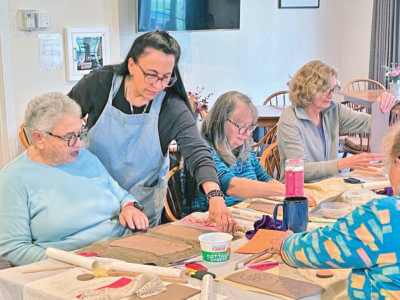Need more volunteers to revive twice-a-week lunches
At BottleRock Napa Valley you can get a deep-fried corn dog stuffed with fish mousse and chopped lobster, topped with remoulade and caviar. It will set you back $26; doctor’s advisory not included.
Read on for the multitude of good eats that are yours for $5 at the Charlotte Senior Center.
11:30 a.m.-12:30 p.m., or until the food is gone.
Bacon cheeseburger sliders, macaroni salad, chips, brownies with ice cream and Arnold Palmer to drink.
White Castle offers two stories about the history of those sliders. One is that these sandwiches are so small they slide down your throat. The second is that once you sit at the counter and order a burger, a server puts it on a ceramic plate and slides it down the counter to you.
Please note that whether it’s sliders or salad, guests at the Charlotte Senior Center eat off porcelain, and this is why volunteer dishwashers are so important. Also, please note that lunch used to be served twice a week. We need more volunteer cooks to be able to do this again.
This is a call-out to everybody, young and old. So far, the youngest volunteer was a homeschooler dropped off by her mother. We’ve also had high schoolers on work-study and college students during semester break.
When we think pasta, we think Italy, but although the exact origins of macaroni salad are unknown, everyone agrees it’s as American as apple pie — and brownies.
In 1934, President Franklin D. Roosevelt and his wife held a picnic at their “Summer White House” in Hyde Park, hosting ambassadors, the Secretary of the Treasury and the publisher of the New York Daily News. Eleanor and friends broiled wieners and made macaroni salad.
Macaroni salad has even appeared in obituaries: “My mom was never the life of the party, but often making the macaroni salad to make the party a success.”
These days, macaroni salad ingredients abound: mayonnaise, oil, vinegar, buttermilk, cream, tahini, capers, chunks of cheese, crab, tuna, shrimp, eggplant … It’s a choose your own salad adventure.
When The New York Times Cooking offers a macaroni salad recipe, opinionated readers weigh in. One expresses enthusiasm; another says, “The most godawful mac salad I’ve ever tasted.” And another adds, “If that’s how they make macaroni salad in New York, I won’t go.”
There are many reasons we need to support newspapers, local and national. Recipes and the discussions they provoke are one good reason for signing up for The New York Times.
Forbes Magazine noted that Palmer House brownies, were featured at the 1893 World’s Columbian Exposition in Chicago, along with the first Ferris wheel, the world’s first moving walkways, Juicy Fruit gum and Pabst Blue Ribbon Beer. Read the history.
 Brownies were listed in the 1897 Sears Roebuck catalogue.
Brownies were listed in the 1897 Sears Roebuck catalogue.
According to The Guinness Book of Records the largest brownie, cooked in Jeddah, Saudi Arabia, on Sept. 23, 2022, was made out of 210 packs of Betty Crocker brownie mix and 504 eggs. It weighed over 335 pounds and took three hours to bake.
You may think a brownie is a brownie but scroll through recipes and you’ll see amazing variety. For me, NYT Cooking’s “formidable new creation” — chocolate cheesecake brownies — sounded like formidable excess. Look elsewhere and you’ll find brownie recipes calling for stout beer, coffee, or raw beets. To each her own.
The potato chip is another food with a story. Popular legend credits a Saratoga Springs chef with inventing it, maybe for a Vanderbilt, in 1853, but “The Cook’s Oracle” a best seller by William Kitchiner, published in 1817, has a recipe for “potatoes fried in slices or shavings.”
So come for Monday Munch at the Charlotte Senior Center on June 5 and Eat American. Then come back on June 12 and Eat Worldwide. Enjoy bulgur, which is a staple in Asia and the Mediterranean basin.
June 12, 11:30 a.m.-12:30 p.m.
A trio of summer salads: bulgur salad with grapes, feta and mint; corn salad; green salad and rhubarb brownies.
Bulgur is believed to have been first eaten in the Euphrates Valley as far back as 5,000 B.C. Some 4,000 years ago, Biblical references mention that it was prepared by ancient Babylonians and Hittites. Around 2,800 B.C., the Chinese emperor Shen Nung acknowledged bulgur as one of five sacred crops along with rice, barley, soybeans and millet. It’s been a staple in the Balkans since the 14th century, when it was introduced there by the Ottoman Turks.
Enjoy your bulgur and be sure to eat your vegetables. Admittedly, in 1947 the U.S. Customs Court in Buffalo, N.Y., ruled rhubarb a fruit, but botanically, it is a vegetable.
In England, rhubarb custard is popular; in Norway, rhubarb soup. In Afghanistan, they add rhubarb to spinach. In Poland, it is cooked with potatoes, and in Iran you’ll find rhubarb in stews. In Italy, “rabarbaro” is a low-alcohol aperitif. “The Escoffier Cook Book” lists rhubarb jam, “confiture de rhubarbe,” noting that “it is one of the most difficult and tedious to make” because in boiling, it tends to burn on the bottom of the pan.
It’s hard to find a happy tune about bulgar or rhubarb, so let’s return to macaroni. “Yankee Doodle” started out as a song sung by British military officers to mock the scrubby colonial Yankees serving with them in the French and Indian War, picturing a stereotypical Yankee who thought he was stylish if he borrowed from a macaroni wig from rococo dandy fashion. But Americans turned the song around, adding verses hailing George Washington and turning an insult into a song of national pride.
Remember: Register for the Thursday Age Well meal pickup by Monday.
Related Stories
Popular Stories
If you enjoy The Charlotte News, please consider making a donation. Your gift will help us produce more stories like this. The majority of our budget comes from charitable contributions. Your gift helps sustain The Charlotte News, keeping it a free service for everyone in town. Thank you.
Andrew Zehner, Board Chair








